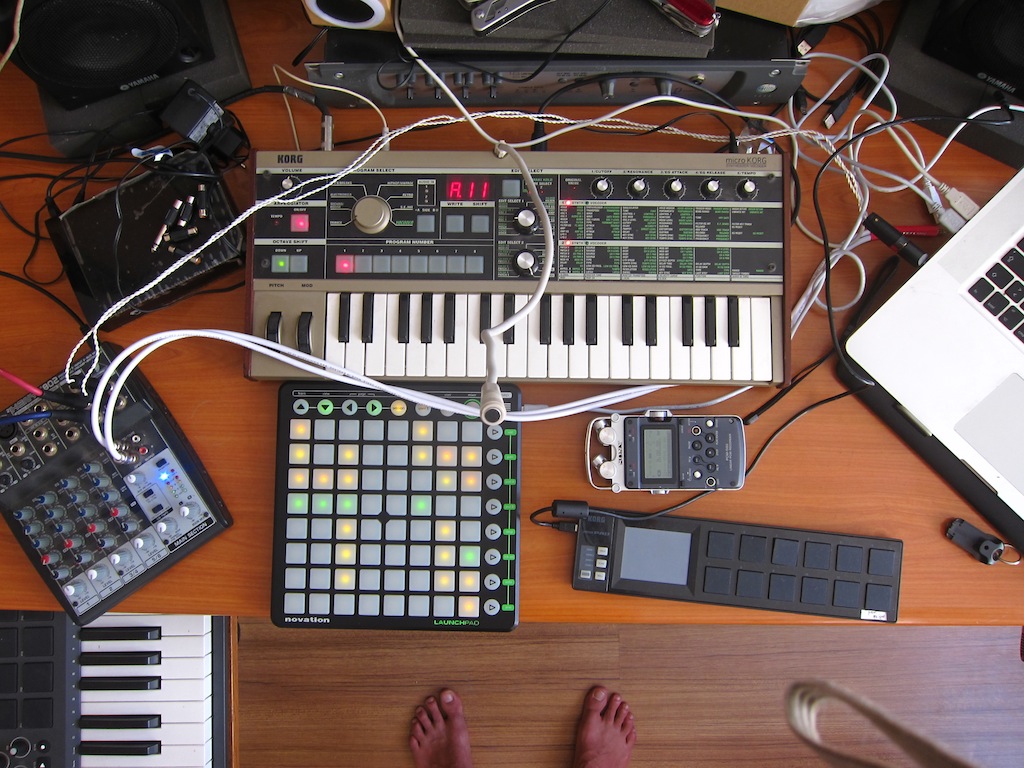Disco Highlife
We begin a deep conversation about technology and music with producer and sound designer Alican Okan, who is also the co-founder of Audio Fil, because he contributed greatly to the renovation of minimüzikhol. He emphasizes that they’re trying to turn the venue into an experimental playground for new media artists and into a whole other experience for guests. We have a lot to talk about this interdisciplinary interaction!
How would you describe your music to a stranger?
To make a theoretical introduction, I cannot limit my style to any genre because they vary a lot. Parallel to my listening habits, my production habits also change often in time. As a result, my music can be full of experiments and surprises. I do enjoy sampling. Maybe because I’ve been dealing with sound design for a long time, I see every material around me as a sound object or an instrument. For instance, I design different instruments by making a vibraphone with bamboo straws or a guitar by tying a steel wire between two trees. I use these recordings and synth- based sounds in my projects. I believe that this brings an idiosyncratic and sound spirit to what I do. It’s very hard to describe it. Can I make them listen? (laughs)
Does it bother you when people say “background music”?
No, it doesn’t. On the contrary, I regard background music as a strategic element. In daily life, we always hear a background music when talking to someone, watching something or entering a new place. We may be unaware of it but this music has an impact on our senses and has the power to shape our mood. For instance, everyone feels uncomfortable in elevators; it’s a place where strangers stand too close to our personal space, which disturbs us even on a subconscious level. Muzak, one of the first edition companies in history, tried to make elevator rides more comfortable and peaceful by playing music.
What would you like to say about the effect of technology on your creative process? Where does technology stand in your life?
For me, technology is one of the cornerstones that create new areas for music production and make it easy to experiment. I try to make time and examine the new visual and vocal technologies and designs. I enjoy trying to figure out how they must have been created. I benefit from this observation when I’m imagining a project. It inspires me by offering faster and more productive methods. The greatest aspect of new media arts is that it gathers science, art and technology under one roof. In this triangular scheme, technology serves as the most important element that reveals science and art. It’s now inevitable that technology is a part of production and creative development. The listener’s options for listening and experience also diversify at a quick pace, which increases one’s options to play with human perception. It’s essential to keep track of technology to adapt to these developments and to be able to create new things. But it’s also possible to let go of natural creativity under the dizzying spell of technology.
What is the process of working on audiovisual performances? How do you achieve a holistic structure?
It depends on the project, which is shaped by the teams and how the roles are distributed. Sometimes we just create sounds, contribute as creative partner or consultant, or put on a stage performance. In some projects, we make compositions for a pre-produced image based on the director’s preferences, or design our own music to reflect that image’s influence on us. We write a composition based on the concept of the project and the venue, and portray the main elements of this composition with light engineers. Besides this, we also build an international communication network in which we provide international consult and implementation support with collaborative projects in Canada and Sweden, of which we’re a part of as A.I. or stage design teams. We put on audiovisual performances. We get together with creators with whom we share certain aesthetic preferences to realize new projects; you somehow have something consistent once you have the preferences and personalities in harmony. There are some cases where creative egos are in the foreground and conflict. The project becomes a success as long as teams listen to each other. Since we’re all artists who enjoy creating experiences, we all work for the satisfaction of putting together a consistent project.

How do you train your ear to adapt to new sounds?
I put together a collection based on the archives of my friends and favorite artists whose taste in music I admire. I research the music of all cultures in the world. I travel a lot to attend light, technology and music festivals or to make speeches at events. I try to share new things with new people and to explore the unknown aspects of new places. I try to observe experimental works and draw my own experiences from them.
What do you think about the future of the music industry?
The music industry changes in parallel with the technology. Since the concept of selling albums has become obsolete, music platforms develop new algorithms to collect copyright fees from musicians, and to produce music that the audience will enjoy listening. Aside from streaming and record sales, live performance is the only thing left for the musicians to earn money. Maybe not for every performance, but the audience wants the event or the live performance they’re seeing to be a unique experience – something beyond when they sit at home and listen to music. Therefore, the venues benefit from new media arts to offer different experiences. In addition to this, I also believe that in the future everyone will be able to make their own music but will stand out with their sound processing skills. I believe that new compositions will be written for quadrophonic or special sound systems instead of the two-channel stereo music systems we’re used to.